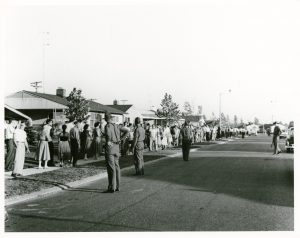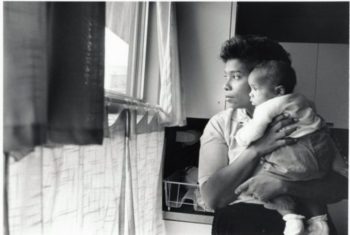

Historical and Geographical Context
From the beginning, Levittown strived to be a model community, and that applied to demographics as well as geography. Levittown included significant numbers of Catholics and Jews along with the Protestant majority. Thanks to generous Federal Housing Administration loans for veterans and the Levitt family’s mass-produced assembly line houses, owning a house was no longer just for the wealthy. Everyone being able to own and live in the same house created a sort of classless utopia where everyone was comfortably middle class. In 1954, The Saturday Night Post noted that in Levittown, “Everybody lives on the same side of the tracks. They have no slums to fret about, no families of conspicuous wealth to envy, no traditional upper crust to whet and thwart their social aspirations.”
However, this impressive diversity in terms of class and religion did not extend to race. Neighborhood covenants and restrictive loan policies did an excellent job at keeping people of color out of Levittown. In fact, by 1953 Levittown was the largest community in the United States (population 70,000) without a single black resident.
The Great Migration of the 20th century saw an estimated six million African-Americans migrated from southern states to northern and Midwestern cities. During the first wave of the Great Migration, African-Americans settled in urban areas such as New York, Pittsburgh, Chicago and Detroit. However, by the onset of World War II, African-Americans were also migrating to cities in California such as Los Angeles, Oakland and San Francisco as well as Washington’s Portland and Seattle. Daisy Myers, for historical context, was one of many African Americans of her age and demographic to make the journey up north.
A reason for the lack of black residences applies to the housing policy adopted post World War II. In addition to the G.I. Bill, the establishment of the Home Owners Loan Corporation was the most important case of residential segregation. The HOLC mandated neighborhoods to adhere to the same social and racial class, implying anything otherwise leaned towards instability and a loss in property values. Low mortgages and low interest were available to areas that accepted these terms. This is an example of the federal government embracing discrimination within the marketplace, and later solidifying it as public policy. Not only did this lead to the lack of black residents in the suburb Levittown but it also influenced a structural form of redlining, of pushing citizens towards certain living spaces based on ethnicity, and of maintaining complete or major racial homogeneity in neighborhoods across America. The housing policies supported the new notion of the American Dream but the American Dream was divided in many ways. The American Dream was not only a desire to live a good life but a desire to assimilate into the American melting pot so they might reap the benefits that came with being an American, no matter where they were from.


The Myers Family
Bill Myers was an electrician who grew up in York, Pennsylvania going to school in a one-room schoolhouse. Later in life he went to Virginia where he met his future wife, Daisy Myers. Raised in Jackson Ward, VA, a predominantly African American town that thrived socially and economically in the 40s and 50s, Daisy loved her life. Jackson Ward was self sufficient and prosperous, earning the titles of the “Black Wall Street of America” and the “Harlem of the South.” The first African American woman to ever be the president of an American bank, Maggie L. Walker, did so in Jackson Ward and opportunities for African American performers such as Duke Ellington and Ella Fitzgerald were abundant along “The Deuce” (2nd Street).
Upon marrying Daisy, Bill told her that he wanted to return to his hometown in Pennsylvania. Though he grew up in a white neighborhood, York was still segregated overall and they struggled to find a realtor to show them housing which they were able to afford. Unfortunately through the consolidation of schools the Myers’ kids were not able to have the same living environment as their father. The situation only worsened when Bill was laid off due to budget constraints. Due to financial instability, the family was forced to move to low-income housing in Philadelphia. With a goal of once again owning a home, Bill worked his way as a repairman and moved to a neighborhood nearby to Levittown. One day in a diner, Bill overheard a group of friends mentioning the possibility of a black family moving into Levittown to pave the way for others of non-caucasian descent. Eventually, Daisy and Bill found a home sizable enough to hold the growing family.
As we now know, the Myers family, the first black family to settle in Levittown, experienced unabashed racism from residents who were sold on the ideals of the largely white American Dream and resisted integration–which was seen as a threat to the Dream. Many other suburbs in America shared this policy of homogeneity, and while large percentages were neutral on integration, they did little to abet the reality of terrorizing nonwhite neighbors that occurred in Levittown for months. The American Dream translated to whiteness in ideals and in execution, and whiteness functioned as property access and legal access to capital.
The Wenschler Family
After the Second World War, new housing was built and the makeup of the population changed. Construction ranged from luxury apartment buildings in Riverdale to public housing in the southern Bronx. During the late 1950’s and into the 1960’s and 1970’s, times and living conditions were changing rapidly for the borough. New rules and regulations contributed to the rapid decline in population during the time. Crime ran rampant during these times as well, with gangs being at an all-time high. Buildings were often set afire, at some times by unscrupulous landlords hoping to collect insurance, and at others by unscrupulous tenants taking advantage of the city’s policy that burned-out tenants should be given priority for public housing and receive money for new furnishings.
Bea was described as having “Bronx-fed street smarts”, further fueling the stereotype of The Bronx as an area of high crime (Kushner 25). This is part of the incentive of the young, growing family to leave the area. People like Lew and Bea Wechsler, who were political activists, were not accepted kindly into the community and often times governmental authority figures took physical action to remove them using threats to their general safety: “As die-hard activists, they had risked everything–their jobs, their security, even their lives–for the sake of social causes” (Kushner 24). The Wechslers, however, were uniquely outspoken in comparison to many other Jewish families living in the Bronx, who opted for a more neutral or even oppositional position to racial integration and civil rights. The Weschlers were willing to risk their opportunities and protection to a certain extent, but it soon came time to prioritize their safety and move to Levittown in the hopes of a more stable and secure future. As an attempt to push racial integration of schools, children were bussed to different districts to attend school, sparking fear and discomfort among parents who worried for the safety of their children from a distance. This encouraged movement from the Bronx area to Levittown in hope of more safety and job opportunities resulting from the new steel factory. The idea of the American Dream- a house with a green lawn and a dog- as well as the promise of job opportunities and a safe community promoted movement to Levittown.
Schoolhouse Rock- “The Great American Melting Pot” Title inspiration of this page- and a great song to boot.
References
“The History of the Bronx, NY.” UrbanAreas.net, urbanareas.net/info/resources/the-history-of-the-bronx-ny/.
Image: ARC2003.2.9, Jack Rosen, 1957, printed 2002. James A. Michener Art Museum Archives
Levittown: Two Families, One Tycoon, and the Fight For Civil Rights in America’s Legendary Suburb David Kushner – Walker & Co. – 2010
“VCU Libraries Digital Collections.” Jackson Ward Historic District | VCU Libraries Digital Collections, digital.library.vcu.edu/islandora/object/vcu:jwh.
